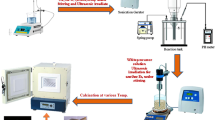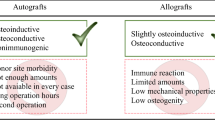Abstract
In the present study new calcium sulfate-based nanocomposite bone cement with improved physicochemical and biological properties was developed. The powder component of the cement consists of 60 wt% α-calcium sulfate hemihydrate and 40 wt% biomimetically synthesized apatite, while the liquid component consists of an aqueous colloidal silica suspension (20 wt%). In this study, the above mentioned powder phase was mixed with distilled water to prepare a calcium sulfate/nanoapatite composite without any additive. Structural properties, setting time, compressive strength, in vitro bioactivity and cellular properties of the cements were investigated by appropriate techniques. From X-ray diffractometer analysis, except gypsum and apatite, no further phases were found in both silica-containing and silica-free cements. The results showed that both setting time and compressive strength of the calcium sulfate/nanoapatite cement improved by using colloidal silica suspension as cement liquid. Meanwhile, the condensed phase produced from the polymerization process of colloidal silica filled the micropores of the microstructure and covered rodlike gypsum crystals and thus controlled cement disintegration in simulated body fluid. Additionally, formation of apatite layer was favored on the surfaces of the new cement while no apatite precipitation was observed for the cement prepared by distilled water. In this study, it was also revealed that the number of viable osteosarcoma cells cultured with extracts of both cements were comparable, while silica-containing cement increased alkaline phosphatase activity of the cells. These results suggest that the developed cement may be a suitable bone filling material after well passing of the corresponding in vivo tests.









Similar content being viewed by others
References
Stubbs D, Deakin M, Chapman-Sheath P, Bruce W, Debes J, Gillies RM, Walsh WR. In vivo evaluation of resorbable bone graft substitutes in a rabbit tibial defect model. Biomaterials. 2004;25:5037–44.
Tay BK, Patel VV, Bradford DS. Calcium sulfate- and calcium phosphate-based bone substitutes mimicry of the mineral phase of bone. Orthop Clin North Am. 1999;30:615–23.
Delloye C, Cnockaert N, Cornu O. Bone substitutes in 2003: an overview. Acta Orthop Belg. 2003;69:1–8.
Ginebra MP, Traykova T, Planell JA. Calcium phosphate cements as bone drug delivery systems: a review. J Control Release. 2006;113:102–10.
Habib M, Baroud G, Gitzhofer F, Bohner M. Mechanisms underlying the limited injectability of hydraulic calcium phosphate paste part II: particle separation study. Acta Biomater. 2010;6:250–6.
Alexander DI, Manson NA, Mitchell MJ. Efficacy of calcium sulfate plus decomposition bone in lumbar and lumbosacral spinal fusion: preliminary results in 40 patients. Can J Surg. 2001;44:262–6.
Pecora G, De Leonardis D, Ibrahim N, Bovi M, Cornelini R. The use of calcium sulphate in the surgical treatment of a ‘through and through’ periradicular lesion. Int Endod J. 2001;34:189–97.
Guarnieri R, Pecora G, Fini M, Aldini NN, Giardino R, Orsini G, Piattelli A. Medical grade calcium sulfate hemihydrate in healing of human extraction sockets: clinical and histological observations at 3 months. J Periodontol. 2004;75:902–8.
Kelly CM, Wilkins RM, Gitelis S, Hartjen C, Watson JT, Kim PT. The use of a surgical grade calcium sulfate as a bone graft substitute. Clin Orthop. 2001;382:44–50.
Doadrio JC, Arcos D, Cabañas MV, Vallet-Regí M. Calcium sulphate-based cements containing cephalexin. Biomaterials. 2004;25:2629–35.
Coetzee AS. Regeneration of bone in the presence of calcium sulfate. Arch Otolaryng. 1980;106:405–9.
Robinson D, Alk D, Sandbank J, Farber R, Halperin N. Inflammatory reactions associated with a calcium sulfate bone substitute. Ann Transplant. 1999;4:91–7.
Rauschmann MA, Wichelhaus TA, Stirnal V, Dingeldein E, Zichner L, Schnettler R, Alt V. Nanocrystalline hydroxyapatite and calcium sulphate as biodegradable composite carrier material for local delivery of antibiotics in bone infections. Biomaterials. 2005;26:2677–84.
Hesaraki S, Moztarzadeh F, Nezafati N. Evaluation of a bioceramic-based nanocomposite material for controlled delivery of a non-steroidal anti-inflammatory drug. Med Eng Phys. 2009;31:1205–13.
Hesaraki S, Moztarzadeh F, Nemati R, Nezafati N. Preparation and characterization of calcium sulfate-biomimetic apatite nanocomposites for controlled release of antibiotics. J Biomed Mater Res B. 2009;91:651–61.
Hesaraki S, Moztarzadeh F, Sharifi D. Formation of interconnected macropores in apatitic calcium phosphate bone cement with the use of an effervescent additive. J Biomed Mater Res A. 2007;83:80–7.
Kokubo T, Kushitani H, Sakka S, Kitsugi T, Yamamuro TJ. Solutions able to reproduce in vivo surface-structure changes in bioactive glass-ceramic A-W. J Biomed Mater Res. 1990;24:721–34.
ISO/EN 10993-5. Biological evaluation of medical devices—part 5 tests for cytotoxicity, in vitro methods: 8.2 tests on extracts.
Lowry OH, Roberts NR, Wu ML, Hixon WS, Crawford EJ. The quantitative histochemistry of the brain. J Biol Chem. 1954;207:19–37.
Elgendy HM, Norman ME, Keaton AR, Laurencin CT. Osteo-like cell (MC3T3–E1) proliferation on biorodible polymers: an approach towards the development of a bone-bioerodible polymer composite material. Biomaterials. 1993;14:263–9.
Iler RK. The chemistry of silica, solubility, polymerisation, colloid and surface properties and biochemistry. New Jersey: Wiley; 1979.
Jeon HJ, Yi SC, Oh SG. Preparation and antibacterial effects of Ag-SiO2 thin films by sol–gel method. Biomaterials. 2003;24:4921–8.
Lazáry A, Balla B, Kósa JP, Bácsi K, Nagy Z, Takács I, Varga PP, Speer G, Lakatos P. Effect of gypsum on proliferation and differentiation of MC3T3–E1 mouse osteoblastic cells. Biomaterials. 2007;28:393–9.
Alliot-Licht B, Gregoire M, Orly I, Menanteau J. Cellular activity of osteoblasts in the presence of hydroxyapatite: an in vitro experiment. Biomaterials. 1991;12:752–6.
Boher M. Silicon-substituted calcium phosphates—a critical view. Biomaterials. 2009;30:6403–6.
Wong KL, Wong CT, Liu WC, Pan HB, Fong MK, Lam WM, Cheung WL, Tang WM, Chiu KY, Luk KD, Lu WW. Mechanical properties and in vitro response of strontium-containing hydroxyapatite/polyetheretherketone composites. Biomaterials. 2009;30:3810–7.
Balamurugan A, Balossier G, Michel J, Kannan S, Benhayoune H, Rebelo AH, Ferreira JM. Sol gel derived SiO2-CaO-MgO-P2O5 bioglass system—preparation and in vitro characterization. J Biomed Mater Res B. 2007;83:546–53.
Habibovic P, Barrere F, van Blitterswijk C, de Groot K, Layrolle P. Biomimetic hydroxyapatite coatings on metal implants. J Am Chem Soc. 2002;85:517–22.
Miyai F, Iwai M, Kokubo T. Chemical surface treatment of silicone for inducing its bioactivity. J Mater Sci Mater Med. 1998;9:61–5.
Uchida M, Kim H, Kokubo T. Apatite forming ability of sodium containing titania gels in a simulated body fluid. J Am Ceram Soc. 2001;84:2969–74.
Salinas AJ, Martin AI, Vallet-Regi M. Bioactivity of three CaO–P2O5–SiO2 sol–gel glasses. J Biomed Mater Res A. 2002;61:524–32.
Palmieri A, Pezzetti F, Brunelli G, Scapoli L, Lo Muzio L, Scarano A, Martinelli M, Carinci F. Calcium sulfate acts on the miRNA of MG63E osteoblast-like cells. J Biomed Mater Res B. 2008;84:369–74.
Stein GS, Lian JB, Owen TA. Relationship of cell growth to the regulation of tissue-specific gene expression during osteoblast differentiation. FASEB J. 1990;4:3111–23.
Mastrogiacoma M, Muraglia A, Komlev V, Peryin F, Rustichelli F, Crovace A. Tissue engineering of bone: search for a better scaffold. Orthod Craniofac Res. 2005;8:277–84.
Pietak A. The role of silicon in Si-TCP bioceramics: a material and biological characterization. Kingston: Queen’s University; 2004.
Hing K, Revell P, Smith N, Buckland T. Effect of silicon level on rate, quality and progression of bone healing within silicate substituted porous hydroxyapatite scaffolds. Biomaterials. 2006;27:5014–26.
Pietak AM, Reid JW, Stott MJ, Sayer M. Silicon substitution in the calcium phosphate bioceramics. Biomaterials. 2007;28:4023–32.
Acknowledgment
The authors wish to appreciate Pasteur institute of Iran for cell culture experiments.
Author information
Authors and Affiliations
Corresponding author
Rights and permissions
About this article
Cite this article
Borhan, S., Hesaraki, S. & Ahmadzadeh-Asl, S. Evaluation of colloidal silica suspension as efficient additive for improving physicochemical and in vitro biological properties of calcium sulfate-based nanocomposite bone cement. J Mater Sci: Mater Med 21, 3171–3181 (2010). https://doi.org/10.1007/s10856-010-4168-4
Received:
Accepted:
Published:
Issue Date:
DOI: https://doi.org/10.1007/s10856-010-4168-4




